A New Database of the Quantitative Cathodoluminescence of the Main Quarry Marbles Used in Antiquity
Abstract
:1. Introduction
2. Materials and Methods
3. Results and Discussion
3.1. Experimental Assay on a Marble Sample
3.2. Quantitative CL Diagrams of the Main Quarry Marbles
3.2.1. Quantitative CL of Carrara Marbles
3.2.2. Quantitative CL of Afyon Marbles and Its Comparison with the Quantitative CL of Carrara
3.2.3. General Quantitative CL Diagrams for the Main Classical Marbles
3.2.4. Other CL Diagrams with Potential Use in Archaeometric Studies of Marble Provenance
3.3. Inter-Laboratory Comparison of CL-Images from the Main Quarry Marbles Used in Antiquity
4. Conclusions
Supplementary Materials
Author Contributions
Funding
Acknowledgments
Conflicts of Interest
References
- Marfunin, A.S. Spectroscopy, Luminescence and Radiation Centers in Minerals; Springer: Berlin, Germany, 1979. [Google Scholar]
- Marshall, D.J. Cathodoluminescence of Geological Materials; Unwin Hyman Ltd.: London, UK, 1988. [Google Scholar]
- Pagel, M.; Barbin, V.; Blanc, P.H.; Ohnenstetter, D. (Eds.) Cathodoluminescence in Geosciences; Springer: Berlin, Germany, 2000. [Google Scholar]
- Boggs, S., Jr.; Krinsley, D. Application of Cathodoluminescence Imaging to the Study of Sedimentary Rocks; Cambridge University Press: Cambridge, UK, 2006. [Google Scholar]
- Machel, H.G. Cathodoluminescence in calcite and dolomite and its chemical interpretation. Geosci. Can. 1985, 12, 139–147. [Google Scholar]
- Reeder, R.J. An Overview of Zoning in Carbonate Minerals. In Luminescence Microscopy and Spectroscopy: Qualitative and Quantitative Applications; SEPM Short Course: Tulsa, OK, USA, 1991; Volume 25, pp. 77–82. [Google Scholar]
- Habermann, D.; Neuser, R.D.; Richter, K. Lower limit of Mn2+-activated cathodoluminescence of calcite: State of art. Sediment. Geol. 1998, 116, 13–24. [Google Scholar] [CrossRef]
- Richter, D.K.; Götte, T.H.; Götze, J.; Neuser, R.D. Progress in application of cathodoluminescence (CL) in sedimentary petrology. Miner. Petrol. 2003, 79, 127–166. [Google Scholar] [CrossRef]
- Renfrew, C.; Peacey, J.S. Aegean marble: A petrological study. Annu. Br. Sch. Athens 1968, 63, 45–66. [Google Scholar] [CrossRef]
- Barbin, V.; Ramseyer, K.; Décrouez, D.; Herb, R. Marbres blancs: Caractérisation par cathodoluminescence. Comptes Rendus Acad. Sci. Paris 1989, 308, 861–866. [Google Scholar]
- Barbin, V.; Ramseyer, K.; Décrouez, D.; Burns, S.J.; Chamay, J.; Maier, J.L. Cathodoluminescence of white marbles: An overview. Archaeometry 1992, 34, 175–183. [Google Scholar] [CrossRef]
- Barbin, V.; Ramseyer, K.; Fontignie, D.; Burns, S.J.; Décrouez, D. Differentiation of Blue-Cathodoluminescing White Marbles. In Ancient Stones: Quarrying, Trade and Provenance; Waelkens, M., Herz, N., Moens, L., Eds.; Leuven University Press: Leuven, Belgium, 1992; pp. 231–235. [Google Scholar]
- Šťastná, A.; Přikryl, R.; Jehlička, J. Methodology of analytical study for provenance determination of calcitic, calcite-dolomitic and impure marbles from historical quarries in the Czech Republic. J. Cul. Her. 2009, 10, 82–93. [Google Scholar] [CrossRef]
- Jarč, S.; Zupančič, N. A cathodoluminescence and petrographical study of marbles from the Pohorje area in Slovenia. Chem. Erde Geochem. 2009, 69, 75–80. [Google Scholar] [CrossRef]
- Lapuente, P.; Nogales-Basarrate, T.; Royo, H.; Brilli, M. White marble sculptures from the national museum of roman art (Mérida, Spain): Sources of local and imported marbles. Eur. J. Mineral. 2014, 26, 333–354. [Google Scholar] [CrossRef]
- Brilli, M.; Giustini, F.; Conte, A.M.; Lapuente Mercadal, P.; Quarta, G.; Royo Plumed, H.; Scardozzi, G.; Belardi, G. Petrography, geochemistry, and cathodoluminescence of ancient white marble from quarries in the southern Phrygia and northern Caria regions of Turkey: Considerations on provenance discrimination. J. Archaeol. Sci. Rep. 2015, 4, 124–142. [Google Scholar] [CrossRef]
- Gutiérrez Garcia-M, A.; Royo Plumed, H.; González Soutelo, S.; Savin, M.-C.; Lapuente, P.; Chapoulie, R. The marble of O Incio (Galicia, Spain): Quarries and first archaeometric characterisation of a material used since Roman times. ArchéoSci. Rev. Archéom. 2016, 4, 103–177. [Google Scholar] [CrossRef] [Green Version]
- Brilli, M.; Lapuente Mercadal, M.P.; Giustini, F.; Royo Plumed, H. Petrography and mineralogy of the white marble and black stone of Göktepe (Muğla, Turkey) used in antiquity: New data for provenance determination. J. Archaeol. Sci. Rep. 2018, 19, 625–642. [Google Scholar] [CrossRef] [Green Version]
- Lapuente Mercadal, P.; Savin, M.-C.; González Soutelo, S.; Gutiérrez Garcia, M.A.; Chapoulie, R.; Laborde Marqueze, A.; Pérez García, P.P. Marble Pieces in the Romanesque Portal of Glory of the Santiago de Compostela Cathedral. New Data through a Multi-Analytical Approach. Int. J. Arch. Herit. 2019. [Google Scholar] [CrossRef] [Green Version]
- Wielgosz-Rondolino, D.; Antonelli, F.; Bojanowski, M.J.; Gładki, M.; Göncüoğlu, M.C.; Lazzarini, L. Improved methodology for identification of Göktepe white marble and the understanding of its use: A comparison with Carrara marble. J. Archaeol. Sci. 2020, 113, 105059. [Google Scholar] [CrossRef]
- Lapuente, P.; Royo, H. Cathodoluminescence for the characterization of ancient marble. Problems and research perspective. In Ancient Quarries and Building Sites in Asia Minor. Research on Hierapolis in Phrygia and Other Cities in South-Western Anatolia: Archaeology, Archaeometry, Conservation; Ismaelli, T., Scardozzi, G., Eds.; Edipuglia: Bari, Italy, 2016; pp. 541–548. [Google Scholar]
- Blanc, P.; Arbey, F.; Cros, P.; Cesbron, F.; Ohnenstetter, D. Applications de la microscopie électronique à balayage et de la cathodoluminescence à des matériaux géologiques (sulfates, carbonates, silicates). Bull. Soc. Géol. Fr. 1994, 165, 341–352. [Google Scholar]
- Blanc, P. A cathodoluminescence Spectrometer built for a SEM JSM840A: First results on minerals and white marbles. In ASMOSIA III. The Study of Marble and Other Stones Used in Antiquity, Proceedings of the 3rd International Symposium of the Association for the Study of Marble and Other Stones Used in Antiquity, Athens, Greece, 17–19 May 1993; Maniatis, Y., Herz, N., Basiakos, Y., Eds.; Archetype: London, UK, 1995; pp. 141–147. [Google Scholar]
- Blanc, P.H. Caractérisation des marbres blancs par cathodoluminescence. In Les Marbres Blancs des Pyrénées, Approches Cientifiques et Historiques; Cabanot, J., Sablayrolles, R., Schenck, J.-L., Eds.; Entretiens d’Archéologie et d’Histoire 2: Saint-Bertrand-de-Comminges, France, 1995; pp. 59–70. [Google Scholar]
- Blanc, P.H. La quantification de la cathodoluminesccence des marbres blancs et de leurs mineraux accessoires. In Proceedings of the Archeomateriaux Marbres et Autres Roches, Actes IVe Conférence internationale ASMOSIA IV, Bordeaux-Talence, France, 9–13 October 1995; Schvoerer, M., Ed.; CRPAA Pub: Bordeaux, France, 1999; pp. 45–54. [Google Scholar]
- Lapuente, M.P.; Turi, B.; Blanc, P. Marbles from Roman Hispania: Stable isotope and cathodoluminescence characterization. Appl. Geochem. 2000, 15, 1469–1493. [Google Scholar] [CrossRef]
- Lapuente, P.; Blanc, P.H. Marbles from Hispania Scientific Approach Based on Cathodoluminescence. In Asmosia 5. Interdisciplinary Studies on Ancient Stone; Herrmann, J.J., Jr., Herz, N., Newman, R., Eds.; Archetype Publications: London, UK, 2002; pp. 143–151. [Google Scholar] [CrossRef]
- Lapuente, P.; Turi, B.; Blanc, P.H. Marbles and coloured stones from the theatre of Caesaraugusta (Hispania): Preliminary study, Bull. Corresp. Hellénique. In ASMOSIA VII, Proceedings of the 7th International Conference of Association for the Study of Marble and Other Stones in Antiquity, Thassos, Greece, 15–20 September 2003; Maniatis, Y., Ed.; 2009; Volume 51, pp. 509–522. [Google Scholar]
- Lapuente, M.P.; León, P.; Nogales, T.; Royo, H.; Preite Martinez, M.; Blanc, P.H. White sculptural materials from Villa Adriana: Study of provenance. In Interdisciplinary Studies on Ancient Stone, Proceedings of the IX ASMOSIA Conference, Tarragona, Spain, 8–13 June 2009; Garcia, M.A.G., Lapuente, P., Rodà, I., Eds.; Arqueologia Clàssica: Tarragona, Spain, 2012; pp. 364–375. [Google Scholar]
- Attanasio, D.; Brilli, M.; Ogle, N. The Isotopic Signature of Classical Marbles; L’Erma di Bretschneider: Rome, Italy, 2006. [Google Scholar]
- Attanasio, D.; Bruno, M.; Prochaska, W.; Yavuz, A.B. A multi-method database of the black and white marbles of Göktepe including isotopic, EPR, trace and petrographic data. Archaeometry 2015, 57, 217–245. [Google Scholar] [CrossRef]
- Prochaska, W.; Attanasio, D.; Bruno, M. Unraveling the Carrara-Göktepe entanglement. In Interdisciplinary Studies of Ancient Stone, Proceedings of the 11th International Conference of ASMOSIA, Split, Croatia, 18–22 May 2015; Poljak, D.M., Marasović, K., Eds.; University of Split: Split, Croatia, 2018; pp. 175–183. [Google Scholar]
- Gutiérrez Garcia, M.A.; Savin, M.C.; Cantin, N.; Boudoumi, S.; Lapuente, P.; Chapoulie, R.; Pianet, I. NMR as a new tool for cultural heritage application: The provenance of ancient white marbles. Archaeometry 2019, 61, 795–808. [Google Scholar] [CrossRef]

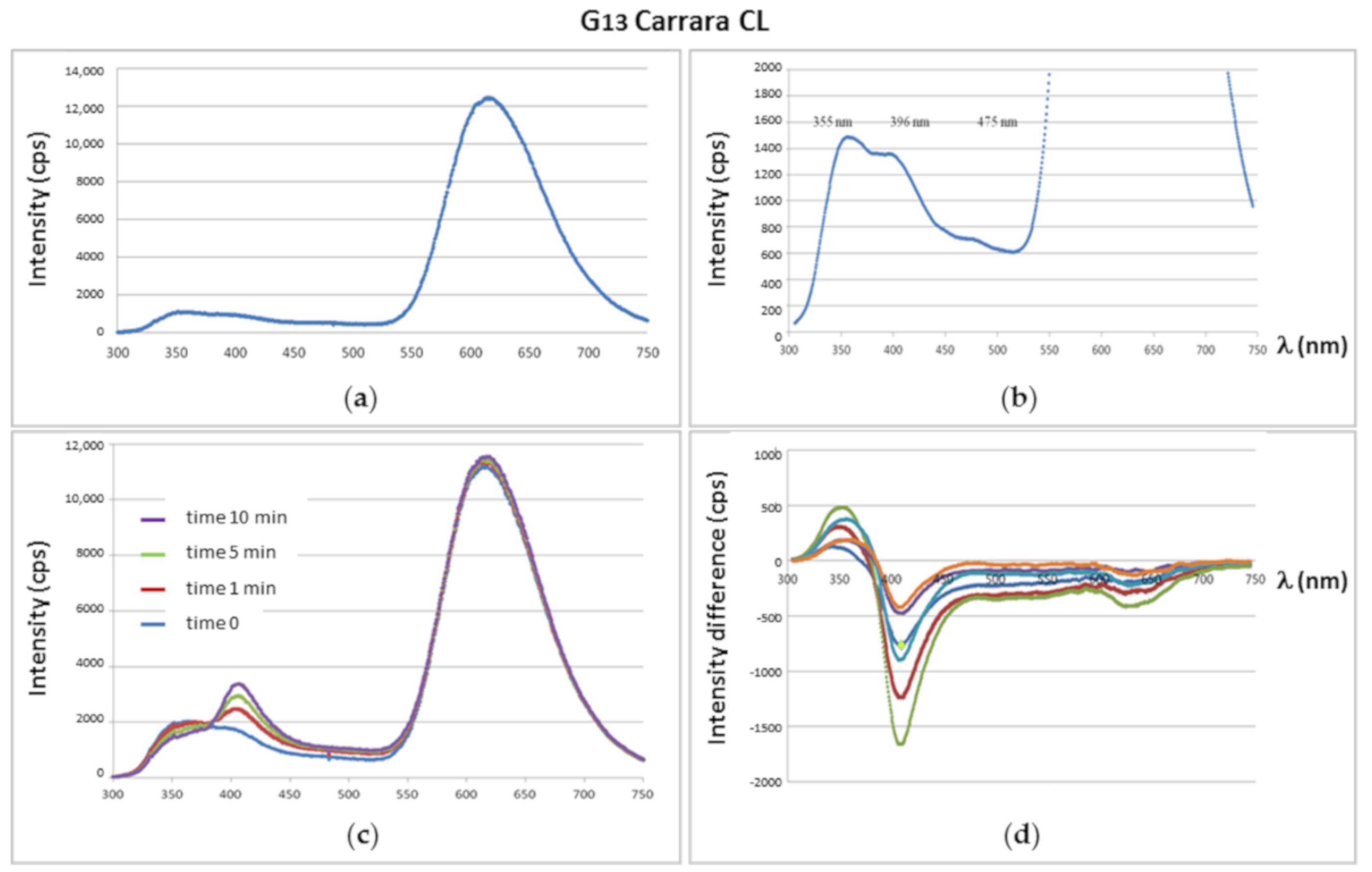


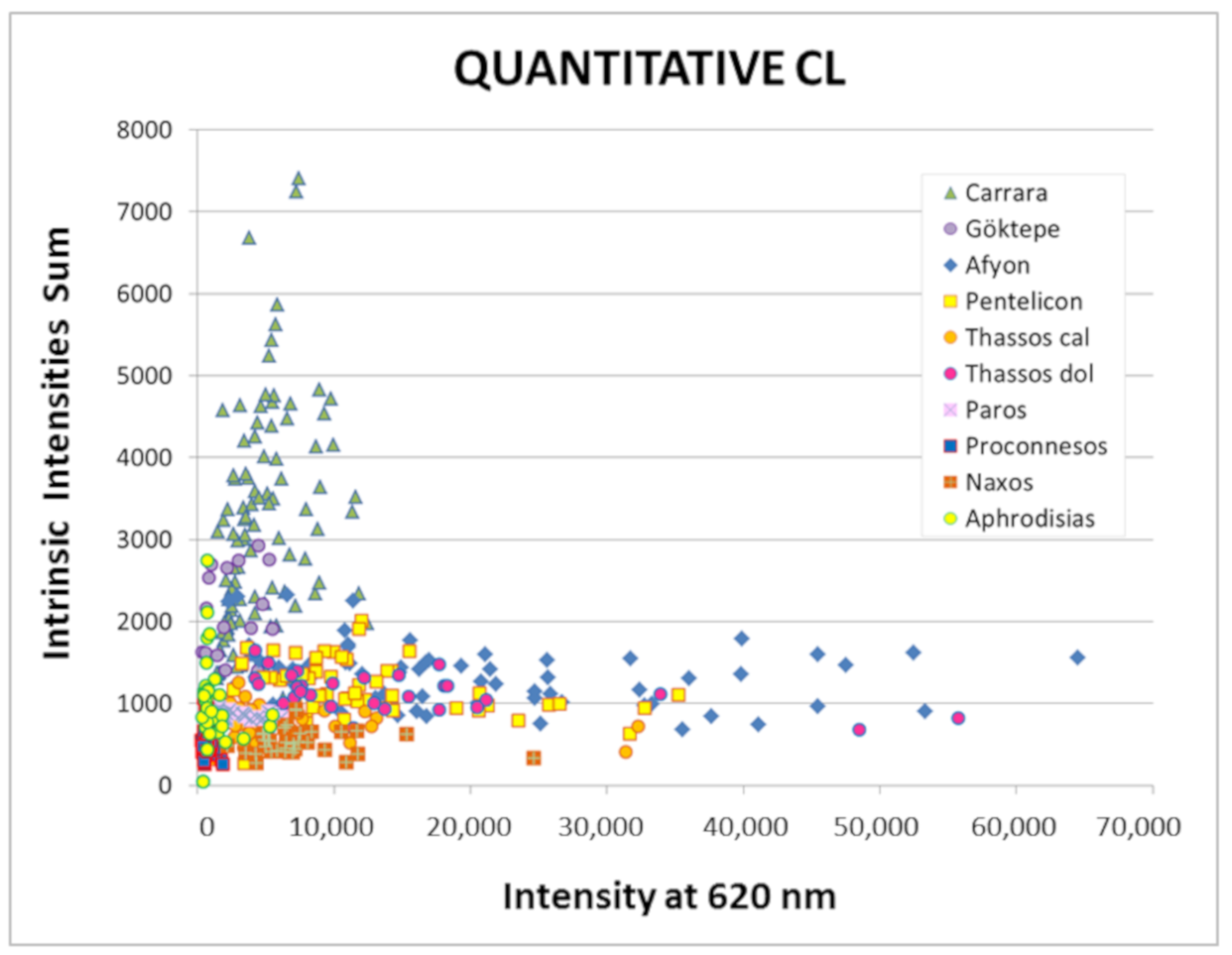
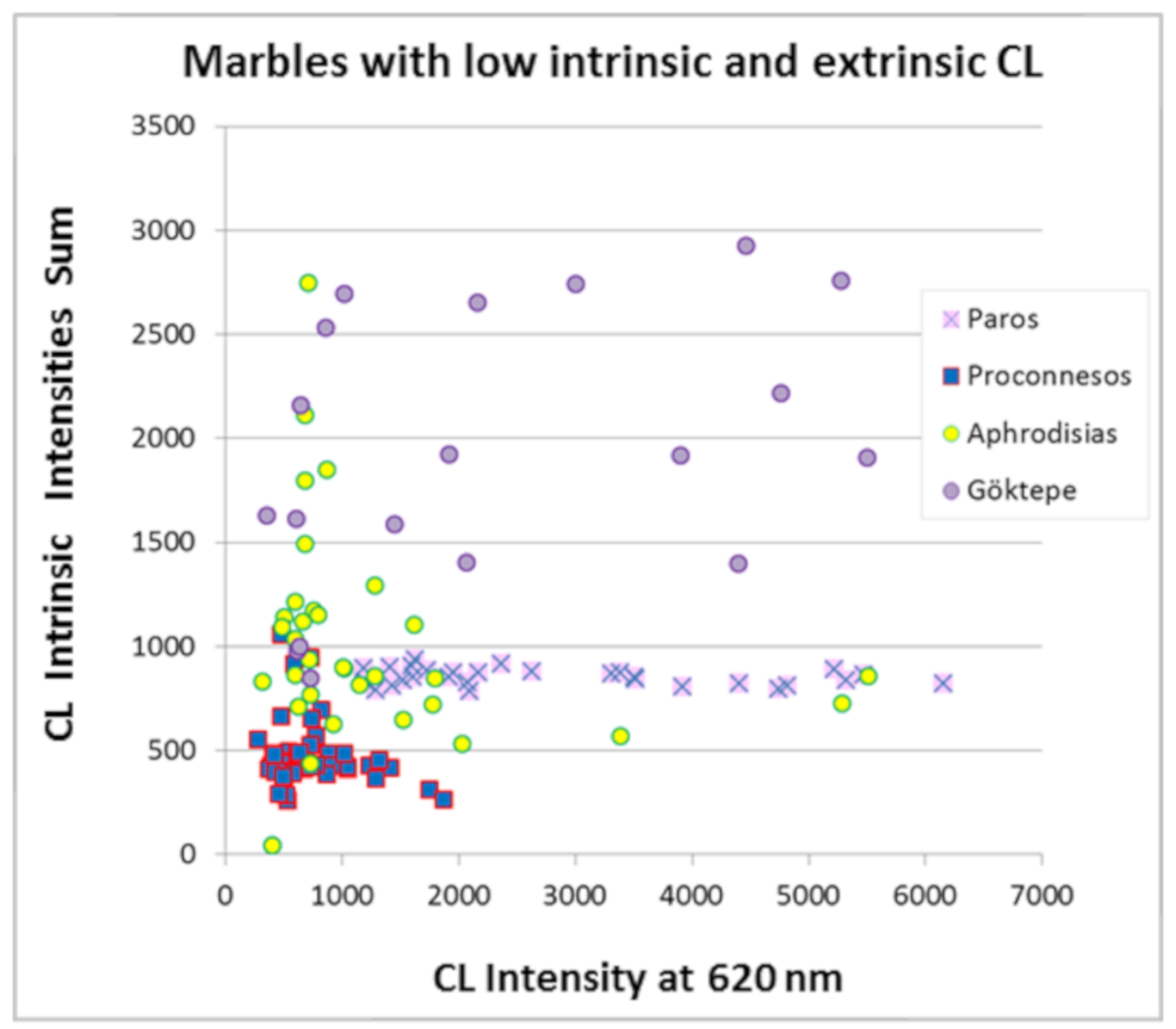


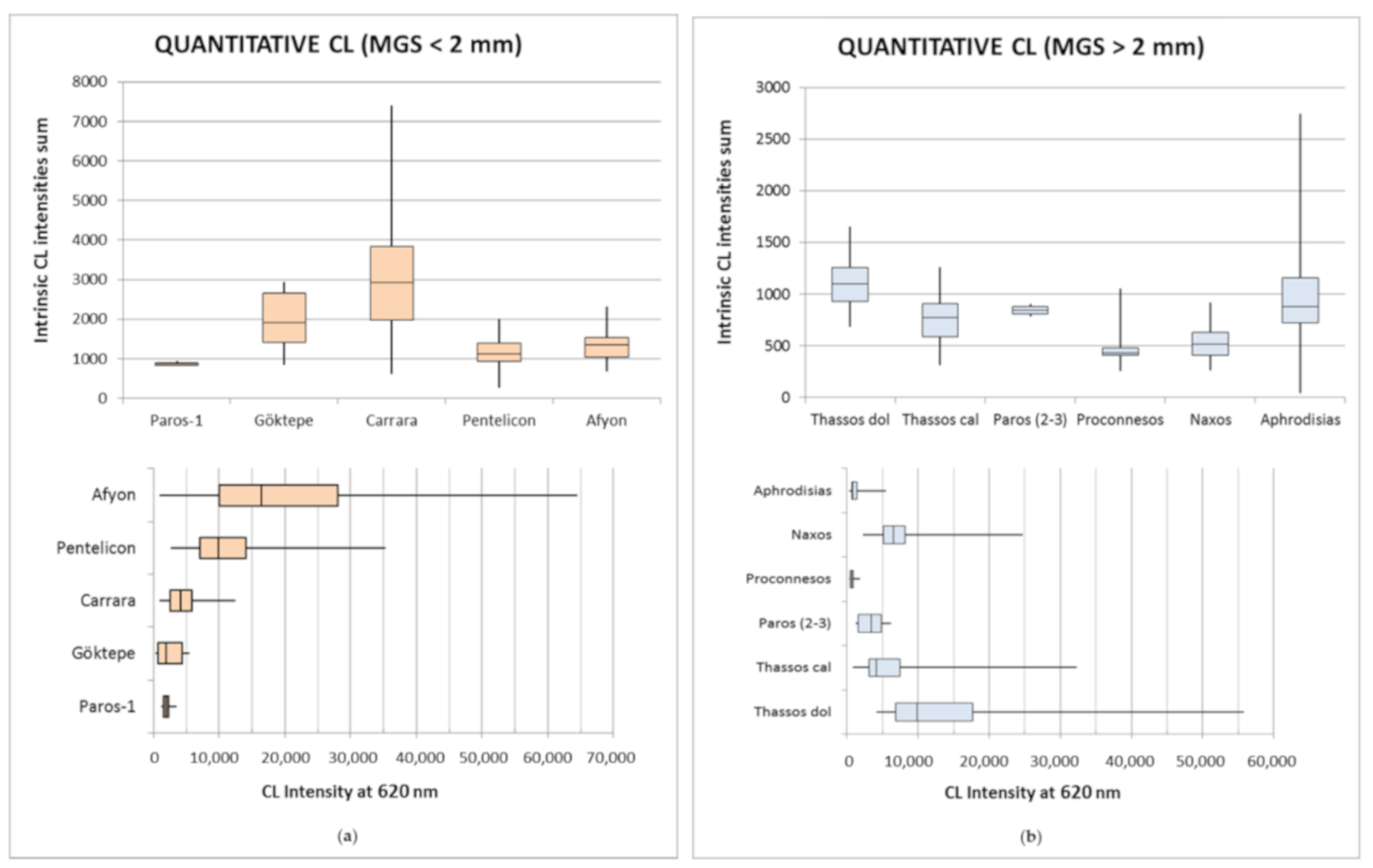
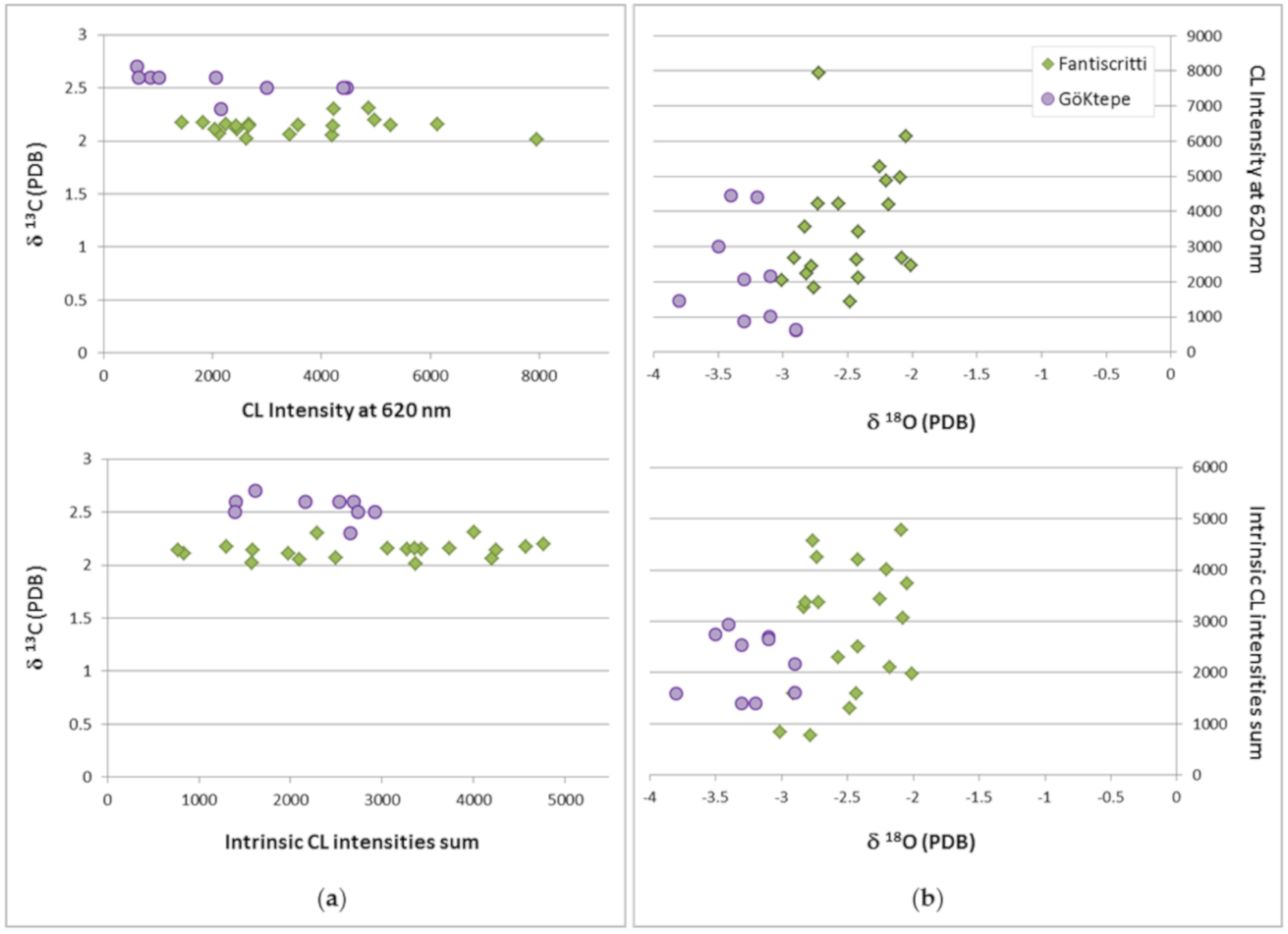

| Quarry (n. Samples) | X (Extrinsic CL) | Y (Intrinsic CL) | Linear (y = ax) a Value | ||||
|---|---|---|---|---|---|---|---|
| Min/Max (Outliers) | Median Q2 | Statistics Dispersion Q1/Q3 | Min/Max (Outliers) | Median Q2 | Statistics Dispersion Q1/Q3 | ||
| Afyon (66) | 864/64,511 (>54,919) | 16,374 | 10038/27,990 | 682/2321 (>2269) | 1360 | 1044/1534 | 0.0418 |
| Thasos dol. (34) | 4201/55,733 (<33,936) | 9858 | 6877/17,701 | 684/1651 | 1104 | 930/1258 | 0.028 |
| Pentelicon (58) | 2668/35,231 (>24,479) | 9864 | 7000/13,992 | 269/2007 (<278) | 1118 | 941/1383 | 0.0686 |
| Naxos (34) | 2209/24,665 (<638) (>12,679) | 6562 | 5153/8164 | 265/921 | 517 | 408/630 | 0.0539 |
| Carrara (110) | 939/12,475 (>10,687) | 4071 | 2523/5789 | 618/7407 (>6667) | 2924 | 1971/3849 | 0.5484 |
| Thasos calc. (38) | 788/32,298 (>13,939) | 4065 | 3086/7427 | 316/1259 | 771 | 584/906 | 0.046 |
| Paros 2–3 (20) | 1183/6155 | 3348 | 1603/4799 | 786/903 | 843 | 809/878 | 0.2067 |
| Göktepe (19) | 353/5504 (>3317) | 1919 | 639/4399 | 848/2928 | 1919 | 1406/2655 | 0.582 |
| Paros−1 (9) | 1195/3513 | 1918 | 1571/2270 | 832/937 (<749) | 871 | 839/899 | 0.3965 |
| Aphrodisias (34) | 320/5510 (>2432) | 744 | 616/1343 | 43/2748 (<63; >1814) | 878 | 720/1158 | 0.3791 |
| Proconnesos (51) | 277/1867 (>1324) | 618 | 484/820 | 259/1058 (>595) | 433 | 410/484 | 0.5207 |
© 2020 by the authors. Licensee MDPI, Basel, Switzerland. This article is an open access article distributed under the terms and conditions of the Creative Commons Attribution (CC BY) license (http://creativecommons.org/licenses/by/4.0/).
Share and Cite
Blanc, P.; Lapuente Mercadal, M.P.; Gutiérrez Garcia-Moreno, A. A New Database of the Quantitative Cathodoluminescence of the Main Quarry Marbles Used in Antiquity. Minerals 2020, 10, 381. https://doi.org/10.3390/min10040381
Blanc P, Lapuente Mercadal MP, Gutiérrez Garcia-Moreno A. A New Database of the Quantitative Cathodoluminescence of the Main Quarry Marbles Used in Antiquity. Minerals. 2020; 10(4):381. https://doi.org/10.3390/min10040381
Chicago/Turabian StyleBlanc, Philippe, M. Pilar Lapuente Mercadal, and Anna Gutiérrez Garcia-Moreno. 2020. "A New Database of the Quantitative Cathodoluminescence of the Main Quarry Marbles Used in Antiquity" Minerals 10, no. 4: 381. https://doi.org/10.3390/min10040381





